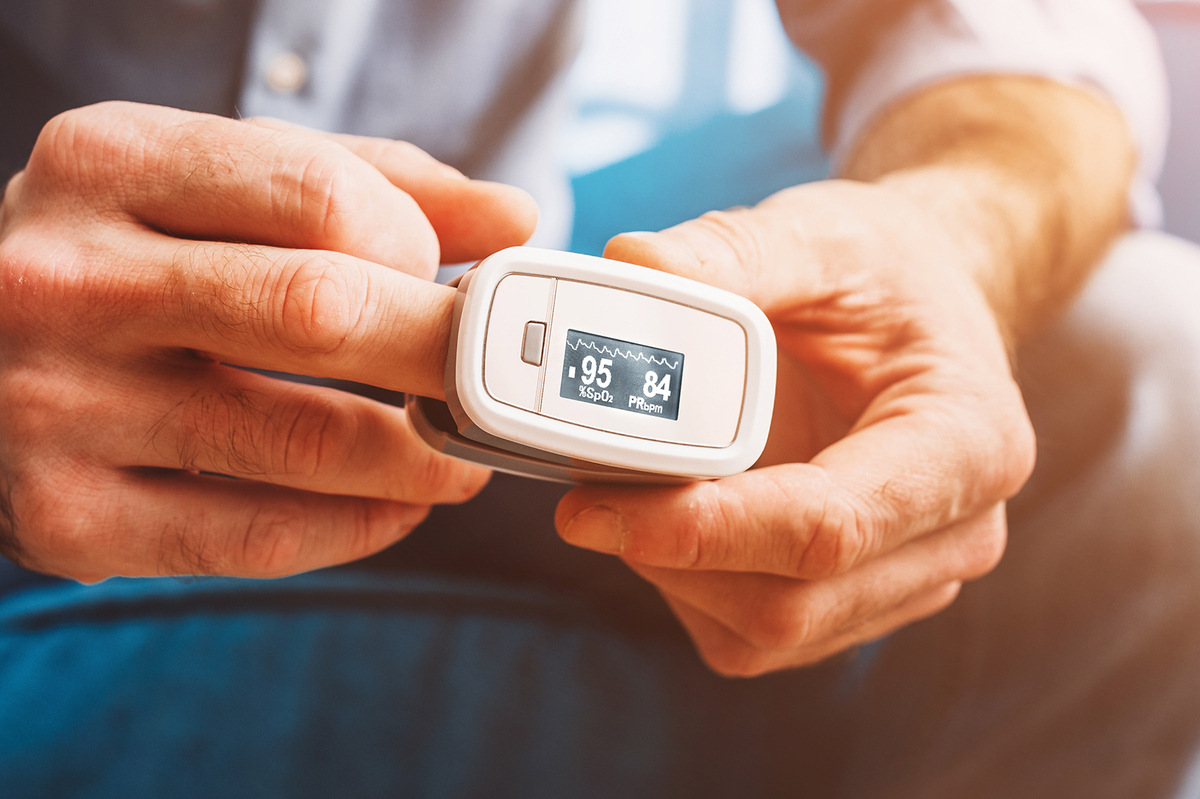Home>Misc>Featured>What Percent Of A HR Should Your Pulse Get For Cardiovascular Fitness


Featured
What Percent Of A HR Should Your Pulse Get For Cardiovascular Fitness
Modified: October 3, 2023
Improve your cardiovascular fitness with our featured article that reveals the optimal percentage of your pulse rate during a workout.
Introduction
When it comes to staying healthy and fit, cardiovascular fitness plays a crucial role. It refers to the ability of the heart and lungs to efficiently supply oxygen-rich blood to the muscles during physical activity. By improving your cardiovascular fitness, you not only enhance your overall health but also boost your endurance and stamina.
One important aspect of monitoring your cardiovascular fitness is keeping track of your pulse or heart rate. Your pulse is an indicator of how hard your heart is working during exercise. By knowing what percentage of your maximum heart rate (HR) you should aim for, you can optimize your workout and achieve optimal benefits.
In this article, we will delve into the concept of cardiovascular fitness and understanding the ideal pulse rate during exercise. We will discuss the target heart rate zone, how to calculate it, and the various factors that can affect it. Additionally, we will explore the different levels of cardiovascular fitness and how to adjust exercise intensity based on your heart rate.
Furthermore, we will explore the benefits of exercising within your target heart rate zone and the importance of monitoring your heart rate during your workout routine. By the end of this article, you will have a comprehensive understanding of the role of pulse and cardiovascular fitness in achieving your fitness goals.
Understanding Cardiovascular Fitness
Cardiovascular fitness, also known as cardiorespiratory fitness or aerobic fitness, refers to the ability of the heart, lungs, and blood vessels to efficiently deliver oxygen and nutrients to the muscles during physical activity. It is a measure of how well your cardiovascular system is functioning and can be improved through regular exercise.
When you engage in cardiovascular exercise, such as jogging, swimming, or cycling, your heart rate increases to meet the oxygen demand of your muscles. Regular cardiovascular exercise strengthens your heart muscle, improves lung capacity, and enhances the efficiency of your circulatory system.
A key component of cardiovascular fitness is the maximum amount of oxygen your body can utilize during intense exercise, known as VO2 max. This measurement reflects the efficiency of your cardiovascular system in delivering oxygen to the working muscles.
Having good cardiovascular fitness offers numerous benefits for overall health and well-being. It reduces the risk of developing chronic diseases such as heart disease, high blood pressure, and diabetes. It also helps manage weight, improves mental health, boosts energy levels, and enhances sleep quality.
Individuals with good cardiovascular fitness have better endurance and can perform physical activities for longer periods without feeling fatigued. They also recover more quickly after intense exercise or physical exertion.
To improve cardiovascular fitness, it is recommended to engage in moderate to vigorous aerobic exercises for at least 150 minutes per week, spread out over several sessions. These exercises should elevate your heart rate and make you breathe harder.
Now that we have a basic understanding of cardiovascular fitness, let’s explore the important role of monitoring your pulse during exercise to optimize your workout and achieve maximum benefits.
Importance of Monitoring Pulse during Exercise
Monitoring your pulse during exercise is a crucial aspect of optimizing your workout and ensuring you are working within the appropriate intensity level. By keeping track of your heart rate, you can tailor your exercise routine to achieve maximum cardiovascular fitness benefits.
Here are a few key reasons why monitoring your pulse during exercise is important:
- Efficient Training: Monitoring your heart rate allows you to gauge the intensity of your workout. By staying within your target heart rate zone, you can ensure that you are working hard enough to challenge your cardiovascular system and improve your fitness, without pushing yourself too far and risking injury or exhaustion.
- Personalized Intensity: Each individual has a different level of cardiovascular fitness. Monitoring your pulse allows you to customize your exercise intensity based on your own fitness level and goals. This ensures that your workouts are challenging enough to make progress, but not overly strenuous.
- Preventing Overtraining: Overtraining, or excessively pushing yourself without adequate recovery, can lead to burnout, decreased performance, and increased risk of injury. By monitoring your heart rate, you can identify when you may be pushing too hard and adjust your training accordingly to avoid overtraining and promote optimal recovery.
- Tracking Progress: Regularly monitoring your pulse during exercise allows you to track your progress over time. By comparing your heart rate during similar workouts, you can see if you are becoming more efficient at delivering oxygen to your muscles and if your cardiovascular fitness is improving.
There are several methods to monitor your pulse during exercise, including using a heart rate monitor or taking your pulse manually. A heart rate monitor is a convenient and accurate way to track your heart rate in real time, providing instant feedback during your workouts. If you prefer a manual approach, you can measure your pulse by placing your index and middle fingers on the inside of your wrist or on your neck.
Now that we understand the importance of monitoring our pulse during exercise, let’s explore the concept of the target heart rate zone and how to calculate it for optimal cardiovascular fitness.
Target Heart Rate Zone
The target heart rate zone is the range of heart rates you should aim for during exercise to maximize the cardiovascular benefits. It represents the optimal intensity level at which your heart is working efficiently and effectively.
Working within your target heart rate zone ensures that you are challenging your cardiovascular system enough to improve its function, while avoiding overexertion or insufficient effort. The target heart rate zone is typically expressed as a percentage range of your maximum heart rate (HR max).
To determine your target heart rate zone, you first need to calculate your maximum heart rate. The most commonly used formula for estimating maximum heart rate is 220 minus your age. However, keep in mind that this is an estimation and individual variations may exist.
Once you have determined your maximum heart rate, you can calculate your target heart rate zone by considering a percentage range. The American Heart Association suggests aiming for 50-85% of your maximum heart rate, depending on your fitness level and goals.
For example, if you are 35 years old and using the formula (220 – 35) to estimate your maximum heart rate, it would be 185 beats per minute (bpm). To find your target heart rate zone, you can multiply your maximum heart rate by the percentages recommended:
- 50% – 85% of 185 bpm = 92.5 bpm – 157.25 bpm
In this example, the target heart rate zone is 92.5 to 157.25 beats per minute. During your workouts, you should aim to maintain your heart rate within this range to achieve the desired cardiovascular benefits.
Keep in mind that the target heart rate zone is a guideline and may vary based on individual factors such as fitness level, underlying medical conditions, and training goals. It is always a good idea to consult with a healthcare professional or a certified fitness trainer to determine the most appropriate target heart rate zone for your specific needs.
Now that we have calculated the target heart rate zone, let’s explore the factors that can affect your target heart rate during exercise.
Calculating Target Heart Rate
To calculate your target heart rate, it is important to understand the maximum heart rate, which is a key component in determining the appropriate intensity for your workouts.
Traditionally, the most widely used formula for estimating maximum heart rate (HR max) is 220 minus your age. However, this formula has its limitations and may not be accurate for everyone. Factors such as genetics, fitness level, and underlying medical conditions can influence an individual’s HR max.
For a more accurate estimation, you can consider using the revised formula for calculating HR max: 208 – 0.7 x age. This formula takes into account the individual variations in maximum heart rate.
Once you have determined your estimated HR max, you can calculate your target heart rate zone by considering a percentage range. The American Heart Association recommends different target heart rate ranges for different levels of intensity:
- Low-intensity exercise: 50-60% of HR max
- Moderate-intensity exercise: 60-70% of HR max
- Vigorous-intensity exercise: 70-85% of HR max
To calculate your target heart rate zone within these ranges, simply multiply your HR max by the corresponding percentages. For example, if your estimated HR max is 180 bpm:
- Low-intensity: 50% – 60% of 180 bpm = 90 bpm – 108 bpm
- Moderate-intensity: 60% – 70% of 180 bpm = 108 bpm – 126 bpm
- Vigorous-intensity: 70% – 85% of 180 bpm = 126 bpm – 153 bpm
In this example, the target heart rate zone for low-intensity exercise would be 90 to 108 beats per minute, for moderate-intensity exercise would be 108 to 126 beats per minute, and for vigorous-intensity exercise would be 126 to 153 beats per minute.
It is important to note that these are general guidelines, and individual variations may exist. Consulting with a healthcare professional or a certified fitness trainer can help you determine the most appropriate target heart rate zone for your specific needs and fitness level.
Now that we have calculated the target heart rate, let’s explore the factors that can affect your target heart rate during exercise.
Factors Affecting Target Heart Rate
While calculating your target heart rate zone using the percentage of your maximum heart rate is a good starting point, there are several factors that can affect your target heart rate during exercise. Understanding these factors can provide further insights into optimizing your workout and achieving your fitness goals.
Here are some key factors that can impact your target heart rate:
- Fitness Level: Your current fitness level plays a significant role in determining your target heart rate. Individuals who are more physically fit tend to have lower resting heart rates and higher maximum heart rates compared to those who are less fit. Therefore, if you are already in good cardiovascular shape, you may need to aim for a higher target heart rate to achieve a sufficient level of intensity.
- Age: As we age, our maximum heart rate naturally declines. This means that the calculated target heart rate zone based on percentages of maximum heart rate may need adjustment for different age groups. It is important to keep in mind that the 220 minus age formula for estimating maximum heart rate has limitations and may not be accurate for everyone.
- Medications and Health Conditions: Certain medications and health conditions can affect your heart rate response to exercise. For example, beta-blockers, commonly prescribed for high blood pressure, can lower heart rate during exercise. If you have any underlying health conditions or are taking medications, it is essential to consult with your healthcare provider to determine the appropriate target heart rate for your specific situation.
- Body Composition: Body composition, including factors such as body fat percentage and muscle mass, can influence heart rate response during exercise. Typically, individuals with higher muscle mass have a higher resting heart rate and may need to aim for a higher target heart rate to achieve the desired exercise intensity.
- Environmental Factors: Environmental conditions, such as temperature and altitude, can impact heart rate response during exercise. For instance, exercising in a hot and humid environment can increase heart rate due to the added stress on the cardiovascular system. Additionally, higher altitudes can cause an increase in heart rate as the body works harder to adapt to lower oxygen levels. It is important to consider these factors when determining your target heart rate.
Understanding these factors and their impact on your target heart rate can help you personalize your exercise routine and make necessary adjustments to optimize your cardiovascular fitness goals. Remember, it is always advisable to consult with a healthcare professional or a certified fitness trainer to determine the most appropriate target heart rate for your specific needs and circumstances.
Now that we have explored the factors affecting target heart rate, let’s examine the different levels of cardiovascular fitness.
Different Levels of Cardiovascular Fitness
Cardiovascular fitness can vary from person to person, depending on factors such as genetics, lifestyle, and exercise habits. Understanding the different levels of cardiovascular fitness can help you assess your current fitness level and set realistic goals to improve your overall cardiovascular health.
There are generally three levels of cardiovascular fitness:
- Low Cardiovascular Fitness: Individuals with low cardiovascular fitness typically have a harder time performing physical activities that require endurance. They may experience shortness of breath and fatigue quickly during exercise. Low cardiovascular fitness is often associated with a sedentary lifestyle and lack of regular exercise. If you fall into this category, you may need to start with light to moderate physical activities and gradually increase the intensity and duration of your workouts to improve your cardiovascular fitness.
- Moderate Cardiovascular Fitness: Individuals with moderate cardiovascular fitness have the ability to perform moderate-intensity physical activities for a reasonable amount of time without excessive fatigue. They may still find intense workouts challenging, but they can maintain a steady heart rate and recover relatively quickly. If you have a moderate level of cardiovascular fitness, you can focus on progressively increasing the intensity and duration of your workouts to continue improving your endurance and overall cardiovascular health.
- High Cardiovascular Fitness: Individuals with high cardiovascular fitness have excellent endurance and can engage in vigorous physical activities for extended periods. They typically have a low resting heart rate and can recover quickly after intense exercise. Those with high cardiovascular fitness often engage in regular aerobic exercise and have a well-conditioned heart and lungs. If you have a high level of cardiovascular fitness, you can focus on maintaining your fitness level through a combination of aerobic exercises and cross-training activities.
It is important to recognize that cardiovascular fitness is not fixed and can be improved with regular exercise and a healthy lifestyle. Regardless of your current fitness level, setting realistic goals and gradually increasing the intensity and duration of your workouts can help you progress to the next level.
Tracking your heart rate during exercise and staying within your target heart rate zone is an effective way to ensure that you are working at an appropriate intensity level for your fitness level and goals. It allows you to challenge yourself without overexertion and gradually improve your cardiovascular fitness.
Now that we have explored the different levels of cardiovascular fitness, let’s learn how to adjust exercise intensity based on heart rate.
Adjusting Exercise Intensity Based on Heart Rate
Adjusting exercise intensity based on heart rate is a valuable tool to optimize your workouts and ensure you are working at the appropriate intensity level for your fitness goals. By monitoring your heart rate and staying within your target heart rate zone, you can effectively adjust the intensity of your exercises.
Here are some guidelines for adjusting exercise intensity based on heart rate:
- Lower Intensity: If you find that your heart rate is below your target heart rate zone, it may indicate that you are not working at a sufficient intensity level to achieve your cardiovascular fitness goals. To increase the intensity, you can consider increasing the duration or speed of your workout or incorporating more challenging exercises.
- Maintain Intensity: If your heart rate is within your target heart rate zone, it means you are working at an appropriate intensity level. Your heart rate is likely to increase during exercise as your cardiovascular system works harder. To maintain this intensity, continue with your current exercise routine or maintain a steady pace during your workout.
- Higher Intensity: If your heart rate is above your target heart rate zone, it may indicate that you are working at a higher intensity level than necessary. This can lead to overexertion and potential risks. To decrease the intensity, you can slow down your pace, take breaks, or choose lower-impact exercises.
Adjusting exercise intensity based on heart rate allows you to make real-time modifications during your workouts. It ensures that you are challenging your cardiovascular system without pushing yourself too hard or risking injury. By fine-tuning your intensity, you can optimize your workouts to achieve your desired fitness goals.
It is important to note that your target heart rate zone is not a fixed range. It may vary based on factors such as your age, fitness level, and underlying health conditions. Therefore, it is recommended to consult with a healthcare professional or a certified fitness trainer to determine the most appropriate target heart rate and guidelines for adjusting exercise intensity based on your specific needs.
Now that we understand how to adjust exercise intensity based on heart rate, let’s explore the benefits of exercising within your target heart rate zone.
Monitoring Heart Rate during Exercise
Monitoring your heart rate during exercise is essential to ensure you are working within your target heart rate zone and maximizing the benefits of your workouts. By regularly checking your heart rate, you can adjust the intensity of your exercises, track your progress, and ensure overall cardiovascular health.
Here are a few methods to monitor your heart rate during exercise:
- Heart Rate Monitors: A heart rate monitor is a wearable device that measures your heart rate in real time. It typically consists of a chest strap or wristband that detects your heart’s electrical signals and transmits the data to a display device. This allows you to continuously monitor your heart rate throughout your workout. Heart rate monitors are accurate and convenient tools for monitoring your heart rate during exercise.
- Pulse Checks: Another method to monitor your heart rate is by manually checking your pulse. You can do this by placing your index and middle fingers on the inside of your wrist (radial artery) or on your neck (carotid artery). Count the number of beats you feel in a 15-second interval and multiply it by four to get the number of beats per minute. While pulse checks may not offer real-time monitoring like heart rate monitors, they can still provide a general indication of your heart rate during exercise.
- Perceived Exertion Scale: Another way to monitor your exercise intensity is by using the perceived exertion scale. This scale ranges from 6 to 20, with 6 being very light exertion and 20 being maximum exertion. By paying attention to how hard you feel your body is working, you can get an idea of your exercise intensity level. However, it is important to note that perceived exertion can be subjective and may not always correlate directly with your heart rate.
Monitoring your heart rate during exercise allows you to make appropriate adjustments to your workout intensity. If you find that your heart rate is below your target heart rate zone, you can increase your effort to achieve a higher intensity. On the other hand, if your heart rate exceeds your target heart rate zone, you can take a break or reduce your intensity to avoid overexertion.
Regularly tracking your heart rate during exercise also enables you to monitor your progress and set realistic goals. By comparing your heart rate during similar exercises or workouts over time, you can assess improvements in your cardiovascular fitness.
Remember, your target heart rate zone can vary based on factors like age, fitness level, and health conditions. It is important to consult with a healthcare professional or a certified fitness trainer to determine the most appropriate target heart rate zone for your individual needs.
Now that we understand the importance of monitoring heart rate during exercise, let’s explore the benefits of exercising within your target heart rate zone.
Benefits of Exercising within Target Heart Rate Zone
Exercising within your target heart rate zone offers numerous benefits for cardiovascular health and overall fitness. By maintaining the appropriate intensity level during your workouts, you can maximize the effectiveness of your exercise routine and reap the following benefits:
- Improved Cardiovascular Fitness: Exercising within your target heart rate zone challenges your cardiovascular system and helps improve its efficiency. By consistently working within the recommended heart rate range, you can strengthen your heart muscle, improve lung capacity, and enhance the oxygen-carrying capacity of your blood. This leads to improved cardiovascular fitness and increased endurance.
- Fat Burning and Weight Management: Exercising within your target heart rate zone promotes fat burning and weight management. When you work at a moderate to high intensity, your body relies more on stored fat as a fuel source. This can contribute to weight loss and help maintain a healthy body composition. Additionally, exercising within your target heart rate zone can boost your metabolism, allowing you to burn calories even after your workout.
- Increased Endurance and Stamina: Working within your target heart rate zone trains your body to sustain higher intensity levels for longer periods. This leads to improved endurance and stamina, allowing you to perform physical activities, such as running, cycling, or swimming, for extended durations without feeling excessively fatigued.
- Reduced Risk of Cardiovascular Diseases: Regular exercise within your target heart rate zone reduces the risk of developing cardiovascular diseases such as heart disease, high blood pressure, and stroke. By strengthening your cardiovascular system, exercise helps lower blood pressure, improve cholesterol profile, and enhance overall heart health.
- Mood Enhancement: Exercising within your target heart rate zone releases endorphins, also known as “feel-good” hormones, which can improve mood and reduce stress. It promotes mental well-being, boosts energy levels, and helps alleviate symptoms of depression and anxiety.
- Long-Term Health Benefits: Regular exercise within your target heart rate zone has long-term health benefits. It can help prevent chronic diseases, such as type 2 diabetes and certain types of cancer. It also strengthens the immune system, improves bone density, and reduces the risk of age-related cognitive decline.
By exercising within your target heart rate zone, you can optimize the benefits of your workouts and improve your overall fitness and well-being. However, it is important to listen to your body and adjust your exercise intensity accordingly. If you experience any discomfort, dizziness, or abnormal symptoms during exercise, it is advisable to consult with a healthcare professional.
Now that we have explored the benefits of exercising within your target heart rate zone, let’s conclude our discussion on cardiovascular fitness.
Conclusion
Cardiovascular fitness is a crucial aspect of overall health and well-being. By engaging in regular aerobic exercise and monitoring your heart rate within your target heart rate zone, you can improve your cardiovascular fitness, endurance, and stamina.
Understanding your target heart rate zone allows you to adjust the intensity of your workouts and maximize the benefits of your exercise routine. By working within this range, you can challenge your cardiovascular system, burn fat, and improve your overall fitness level.
Monitoring your heart rate during exercise gives you valuable insights into your intensity level and helps you make real-time adjustments. Whether you use a heart rate monitor, manually check your pulse, or rely on perceived exertion, regularly monitoring your heart rate allows you to track your progress and ensure that you are working at an appropriate intensity.
Exercising within your target heart rate zone comes with a multitude of benefits. It improves cardiovascular fitness, aids in weight management, increases endurance and stamina, reduces the risk of cardiovascular diseases, enhances mood and mental well-being, and provides long-term health benefits.
Remember, your target heart rate zone is individualized and can depend on factors such as age, fitness level, and health conditions. Consulting with a healthcare professional or a certified fitness trainer can help you determine the most appropriate target heart rate zone for your specific needs.
So, lace up your sneakers, track your heart rate, and embark on a journey to enhance your cardiovascular fitness. By exercising within your target heart rate zone, you can achieve optimal results and enjoy the multitude of benefits that come with improved cardiovascular health.







